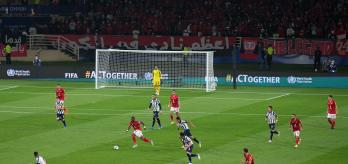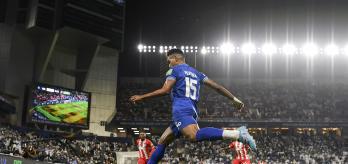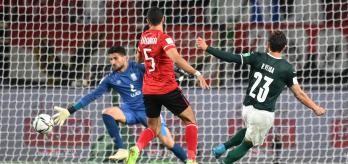A crowd of 32,871 created a carnival atmosphere at the Mohammed Bin Zayed stadium as the drama unfolded in what was an intriguing tactical battle. Chelsea took the lead when Romelu Lukaku headed home from a Hudson-Odoi cross before Raphael Veiga equalised from the penalty spot, sending the game to extra-time.
The game’s most decisive moment came when Chelsea were awarded a penalty for a handball by Luan with just three minutes of extra-time remaining. Kai Havertz scored from the spot to secure a first ever FIFA Club World Cup title for the Blues, to the delight of their travelling support. Throughout the tournament, our Technical Study Group (TSG) analysed every minute of every match and all were in agreement that the final was a captivating battle between two greatly contrasting styles.
Eventual winners Chelsea, were proactive and attacking in their approach, dominating possession, generating 20 attempts at goal and scoring their only two shots on target. Palmeiras set up in a low block, looking to hit Chelsea on the counterattack. Despite only creating 10 attempts at goal, they had three efforts on target, scoring one.
The data
Looking at the teams’ defensive performances, their contrasting styles are strongly evident in the data presented by our football performance analysis and insights team. Palmeiras had a huge 1,270 defensive actions in the game, the most of any team in any one game in the competition, whilst Chelsea had just over half of that number with a total of 684. The Copa Libertadores champions were also ranked first for the most defensive pressure events (Pressing and Pushing On) in a single match with 1,115.
The numbers contrast starkly when the teams’ in-possession data is analysed. Chelsea completed 724 distributions with an 86% success rate whilst Palmeiras only completed 222 with a 57% success rate. However, despite both teams approaching the game in very different ways, they were level on 20 final unit line breaks each, demonstrating the effectiveness of their opposing styles.
Palmeiras 6-2-2 low block
In a real shift from their attacking approach in the semi-final against Al Ahly, Palmeiras adopted a low-block counter-attacking strategy for this game against Chelsea. Out of possession, their back four played narrow with their two centre-backs marshalling (9) Lukaku, whilst their full-backs man-marked Chelsea’s inside forwards, (19) Mount and (29) Havertz.
Their designated wide forwards (14) Scarpa and (10) Rony were tasked with tracking and dealing with Chelsea’s wing-backs, (28) Azpilicueta and (20) Hudson-Odoi. In midfield, (28) Danilo and (8) Ze Rafael had the responsibility of screening balls into Lukaku whilst also picking up (7) Kante and (8) Kovacic. Their highest pair of (23) Veiga and (7) Dudu were responsible for trying to prevent Chelsea’s left and right centre-backs from stepping in with the ball, leaving (6) Thiago Silva as the spare player.
This meant that Palmeiras were prepared to allow (6) Silva to step in with the ball but wanted to protect the central part of the pitch and prevent it going in to (9) Lukaku. When they won the ball back, they broke quickly, always trying to release (7) Dudu who was often positioned so he could go 1v1 against (4) Andreas Christensen. By allowing, and even encouraging Silva to step in with the ball, Palmeiras were trying to lure in Chelsea’s strongest defender so he would be out of the equation on the counter-attack leaving it 2v2 against Christensen and (2) Antonio Rüdiger.
Average positions
When we examine both teams’ average positions, when Chelsea have the ball, over the course of the game, it is clear to see the distinct approaches from Palmeiras who were mostly deep in their own half with (7) Dudu as their most advanced player and intended outlet on transition.
It contrasts with how high Chelsea’s average positions are and justifies why 97% of Chelsea’s distribution was under indirect pressure or no pressure at all. In addition, Palmeiras’ consistent low block meant that out of Chelsea’s 855 total distribution and use of possession events, 648 failed to break a Palmeiras line.
Palmeiras’ deployment of this defensive system meant that (10) Rony, usually a key attacking player, had to accept a role in his team that required him to play in a very deep position, often on the outside of his right-back, connecting into the back six.
Regarding this defensive role, Steve McClaren commented: "He’s usually very effective for Palmeiras as the lone striker and was often a target for the goalkeeper’s long kicks. In the semi-final, he worked very hard, pressed from the front and ran in behind, was full of energy and was a real threat so the biggest shock for me was seeing him in that right-hand side position following Hudson-Odoi all the way back to create that six across the back and try to negate the five-lane attacking approach of Chelsea."
Alberto Zaccheroni said he was disappointed with how Palmeiras set up because he felt they were just too far from the Chelsea goal when they won the ball back and made it very difficult for themselves.
"Palmeiras were too worried about closing down space and hoping to strike on the counter, but it's very hard to catch Chelsea out on the counter especially when coming from such a deep position. I think they gave Chelsea too much control of the ball in midfield and we saw that even when they defended in numbers, they didn’t always mark very well. Chelsea won because they were braver, brave enough to attack."
Chelsea starting approach
Because Palmeiras set up in a low block, Chelsea really dominated possession in this game and spent most of the time trying to build play from the halfway line. As discussed in the TSG’s preview of the final Chelsea started with three at the back, pushing their wing-backs high, connecting them to their attacking three so they could populate the five channels of the pitch, in their bid to break down the Palmeiras defence. Because Palmeiras were in a low block, Chelsea offered to receive in front of their opponent’s team shape 281 times in this game. This was more than any other team in a single game, in the entire tournament.
Thomas Tuchel’s side were also ranked first for receiving the ball in front of the opposition team shape per 90 minutes (average over two games of 413), with 570 in the final match. This contrasts starkly with their 254 in the semi-final against Al Hilal, who were more proactive and aggressive in their pressing style. Chelsea also completed the most step ins (23) of any team per 90 minutes in the tournament clocking the most in a single match (28) in the final against Palmeiras.
Of those 28, Kovacic and Christensen accounted for almost half of those. With Thiago Silva permitted to have the ball, Chelsea’s wide forwards, (29) Havertz and (19) Mount were dropping in, attempting to get between the Palmeiras lines whilst their wing-backs pushed high. Centre midfielder (7) Kante was also advancing to create numerical supremacy in front of Palmeiras’ final unit.
Havertz was the top ranked player for offers to receive (35) between units 2 & 3. When Mason Mount was withdrawn through injury after 32 minutes, (10) Christian Pulisic replaced him and went on to record the second-highest number of offers to receive between units 2 & 3 of 24.
Crucially when attacking, Chelsea generally maintained a good rest defence, ensuring they had a spare defender to ensure a 3v2 in their favour if, and when Palmeiras won the ball and tried to counter-attack. If Sliva stepped in to try to create to penetrate open space, then either Kovacic or Kante would hold in a deep position alongside the other two centre-backs.
Pascal Zuberbühler also noted how goalkeeper Mendy’s position was always supportive and connected to the rest defence. "Mendy’s positioning is also great for supporting the Chelsea rest defence. He is high and can almost be a sweeper keeper if the ball breaks in behind the centre-backs."
Break-through goal
Chelsea’s lead goal in the game came as a direct result of their inside forwards dropping in deep and their wing-backs pushing high. On this occasion, (8) Kovacic drifted into a wide position to receive the ball before stepping into the space that had been vacated by (29) Havertz. The forward pass allowed (20) Hudson-Odoi to receive in behind Palmeiras’ final unit. With five Chelsea players making runs into the box, the wing-back delivered an inch-perfect cross to Lukaku who headed beyond Weverton.
Steve McClaren explains the issue with man-for-man marking in general play: "It’s a great goal. Havertz dragging the full-back down starts it and creates a chain reaction of Palmeiras players losing their men. Kovacic steps in, Hudson Odoi crosses and Chelsea have five players in the penalty area. The issue with 1v1 defending is when one player is beaten, someone has to be left free. Then Palmeiras’ defenders get caught ball-watching and this is what Chelsea rely on, allowing Lukaku to get on the end of the cross."
Chelsea change to 4 at back
In some of their games leading up to the FIFA Club World Cup, Chelsea had been playing with four at the back. Despite starting both the semi-final and final with his favoured 3-4-3 system, Tuchel changed to a back four for the second period of extra-time.
Despite the change in shape, the principles of Chelsea attacking play did not change as they continued to populate the five channels. Their wide forwards added width with their attacking midfielders occupying the channels either side of Havertz, who had moved into the centre-forward role.
Centre midfielder, (7) Kante was dropping in beside the two centre-backs to build play while the full-backs advanced to support the attack but also to shape a rest defence should Chelsea lose the ball. Kante was looking to play wide to isolated wingers, whilst Chelsea now looked to create overloads approaching the second post to make it difficult for the Palmeiras defenders to pick up runners.
Chelsea’s capacity to be flexible in their tactical approach to the game proved to be decisive in the winning of the game. According to Alberto Zaccheroni, game-intelligent, technical players will find a way to break down a structured, organised defence.
"Playing against this type of defence you need very good players to break it down. Chelsea have players who can ask different questions of their opposition. Havertz can play wide and come out to in but can also drop into pockets and make runs from central positions. Lukaku is a real presence through the middle and also when he started to drift off behind centre-backs. Werner gave great width on left channel and with midfield players who can step in with the ball they are a very difficult side to play against and contain. Their approach to the game was very positive though and they deserved to win the match."

























